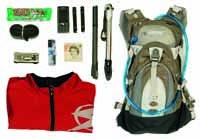 What to carry out
What to carry out
Got the bike, got the helmet, got the shorts and the backpack, but what should I put in the backpack?
Recommendations please for what essentials I should carry, eg, inner tube, toolkit etc. Also, what should be used to clean the bike after the ride?
Alibali65 (on the forum 27/03/2008)
Clever, fold-up, miniature trail tools are available from manufacturers like Topeak. If a malicious thorn helps to extract the air from your tyres you will also need tyre levers and an inner tube, or for tubeless tyres, some self-adhesive patches.
As your tyres age they become more prone to punctures. Topeak, Blackburn and other manufacturers make mini pumps that will allow re-inflation out and about.
Extra clothing is also vital. Layering thin ‘wicking’ garments is your key to avoiding getting cold as you perspire. A Gore-Tex waterproof jacket combined with a baselayer can be quickly donned over a Lycra jersey if the weather turns bad. They can be scrunched up or stashed in a stuff sac, and will take up very little space in your pack. Look for cycle-specific designs from Gore Bike wear, Endura, or Altura.
There’s the question of food too. You’re burning off calories at a much higher rate than normal. You’ll need to pack the right food to provide energy, and liquids to avoid dehydration.
Specific sports foods are available in different forms and Science in Sport (SIS) has an excellent range of sports nutrition through cereal bars, energy gels, and drinks, one of which is designed to help you recover post-ride (Rego). A mix of these products works well. Energy gels can be consumed on the fly, with a couple of cereal bars to eat during breaks and for after the ride. For variation, there’s the old cyclists’ standby, the banana.
Shimano v Crank Bros.
I’ve recently bought a Santa Cruz Heckler and I’m thinking of joining the SPD clan. My mate uses Crank Bros Mallets on his DH bikes and he defends them to the death! But I’ve been looking at the Candys and some of the reviews I’ve read have said that they’re crap. So can anyone help? Either a Candy, or a Shimano M545 or M647? Anyone have ideas or experience?
Mattaw (on the forum 14/03/08)
The Shimanos and the Crank Bros Candy pedals represent two of the main types of pedal that are available to clipless users.
The stripped down design from Crank Bros is the response to the slightly more complex design of Shimano, the originator.
The core difference, which affects performance and durability, is that the Crank Bros relies on one spring to tension the cleat bindings on both sides, whereas the Shimano design has two.
Fewer parts on the Crank Bros pedal result in its claim of improved mud shedding. The spring is wound around the axle, and the space that’s left between the cleat binding and the pedal body allows it to clear itself. But almost as annoying as not being able to engage with the pedal due to mud build-up, is the lack of a positive click to tell you you’re in. This is the unfortunate side-effect of relying on one overworked spring.
The answer lies in the Shimano M647. An outer nylon body surrounds a version of the familiar shimano SPD two-spring design. There are clear gaps between it and the metal inner part to allow the clag to clear. The casting of the central binding has been refined to stay unclogged.
The clever feature of an extra spring to tilt the inner binding up to catch the front edge of the cleat has been retained. The nylon outer part is lighter and more resilient than if it were made from alloy.
The other advantage is delivered through a wider base surrounding the binding. This will support your foot, once engaged, and counter the danger of hot spots, where flex around the cleat mounting on the shoe creates soreness. You can also pedal with shoes with no cleats.
Hitting the road
I’m very happy with my mountain bike. But there’s now the option of a financial scheme at work, allowing me to buy a bike to commute on. What should I be looking for?
Nigel Benn, West Wickham
Just as the proliferation of mtbs has meant there’s a different model for every kind of ride, terrain and physique, there’s a similar plethora of machines for our roadie brothers.
First of all, you should consider the length of your commute, and how much you want to spend. Do you need a hybrid or a roadbike? The straight or riser bars fitted to some hybrids suit an urban rider looking for an upright riding position, quick responsive handling, with brake levers never far from the fingertips. But if you’re considering a commute over say five miles, the multiple hand positions available to you on a drop handlebar will provide more upper body comfort.
Some hybrid gear components are based on mtb ratios. For stop-starting (eg riding away from lights) while in town, these are fine, but on more open stretches of road they might be a bit light.
How much do you carry? Many entry and mid-level road bikes have drillings for racks and mudguards, and there’s more and more well designed, weatherproof luggage aimed at the cycle commuter, available all the time.
Just like the mtb market, the best bargains are available online, but similarly, sizing is critical. Many online mail order sites now have handy sizing guides. But you can’t beat the fitting process done with the bike in front of you. Are you going to need after sales service? Many bike shops will offer tuning as the bike wears in.



